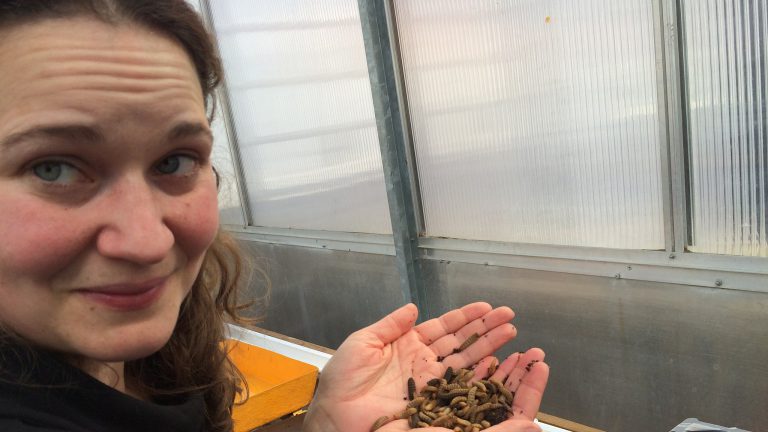Datum: 30/9 – 2019 | Tid: 10:30 | Plats: Lärosal L, Ulls hus, Ultuna campus
Är biologiskt nedbrytbart avfall ett problem eller en resurs? Vissa hävdar att det är en resurs som kan tas till vara bättre, men varför görs det inte? Hur skulle en bättre hantering kunna se ut? Om dessa frågor låter intressanta, kom och lyssna på Cecilias docenföreläsning. Nedan finns en engelsk sammanfattning av föreläsningen, som kommer att hållas på engelska. Mer info om alla docentföreläsningar som hålls på Ultuna nu hittas här: https://www.slu.se/ew-kalender/2019/9/docentforelasningar-vid-nj-fakulteten/
Turning waste to value – Valorisation of biodegradable waste using Invertebrates
Solid waste management is a service that is to be provided by municipalities, however many municipalities around the world struggle to provide their citizens with adequate level of service. Globally, 70% of solid waste is landfilled or dumped. Almost half of the waste that is landfilled or dumped (44%) is of biodegradable organic matter. When the organic matter is decomposed at these sites, a large fraction will be degraded anaerobically, which causes release of greenhouse gases that contribute to climate change. In addition, the leachate contains heavy metals and plant nutrients that contribute to eutrophication when reaching water bodies, and microbial pollutants that can cause disease transmission. One reason the fraction of organic matter that is landfilled is so high is that the cost of treatment generally is higher than the possible revenue from selling the products, such as compost. One way to minimise the risks with inadequate management of the biodegradable fraction is to find way to better utilise the resources captured in this fraction. This could be done by introducing treatments that generate products of higher value, so that the treatment can bear more of its own cost. One novel treatment for biodegradable waste valorisation is fly larvae treatment, in which organic waste is converted into larval biomass that can be used as animal feed and a treatment residue that can be used as an organic fertiliser. Converting the biodegradable fraction to animal feed (indirectly) utilises the resources in the waste more directly and therefore the losses are smaller and hence the efficiency in terms of resource utilisation larger. This is in line with the action plan for a circular economy, launched by the European commission in 2015.
The most commonly used fly in fly larvae treatment is the black solider fly (Hermetia illucens (L.), Diptera: Stratiomyidae) that originates from the Americas. This fly is of interest because the larvae are large and thus easy to separate from the treatment residue, and because the fly does not eat as adult and therefore is not a vector for disease transmission. We have found that the content of microbial and environmental pollutants decreases in the fly larvae treatment and that the greenhouse gas emissions from the treatment are low compared to other biological treatments. The fly larvae treatment system we have developed at SLU comprise of two main components: 1) decentralised waste treatment units, at which the conversion of waste into insect biomass takes place; and 2) a centralised rearing and refining facility, at which the young larvae required for the treatment are reared and the products from the decentralised waste treatment units are treated to guarantee high product quality. The treatment is done in small batch modules that each have the capacity to treat 15 kg in the two weeks process. These smaller modules can be aggregated to larger modules and by doing so the treatment capacity can be adapted to the waste volumes in a dynamic way. This flexible modular waste treatment allows for decentralised treatment at the site where the waste is generated, and thereby reduce the need for waste transport. Most of our research has focused on food waste, and we have found that it is an optimal substrate for fly larvae treatment, yielding large quantities of fly larvae per treated volume waste. According to current European legislation, food waste is not allowed as fly larvae substrate, due to the content of meat. The research focus has thus shifted to plant-based waste sources, such as reclaimed bread and vegetable and fruit peels. These substrates are, however, not optimal for fly larvae treatment as the nutrients are not easily available to the fly larvae. In order to achieve higher efficiency with these substrates, we have evaluated different pre-treatments and found that fungi pre-treatment is an efficient way of making complex bound nutrients more available to the fly larvae. We have also found that the protein content of the larvae does not change much with the substrate the larvae are reared in, but the fat content and characteristics changes a lot. The composition of the larvae is important to know in the refining of the larvae to either animal feed or other technical uses. The focus of the we are currently conducting is on further system development, including better understanding of pre-treatments, deeper understanding of how substrate impact on the larval composition, a better understanding of the environmental impact of the system, as well as continued system development for full-scale implementation.

